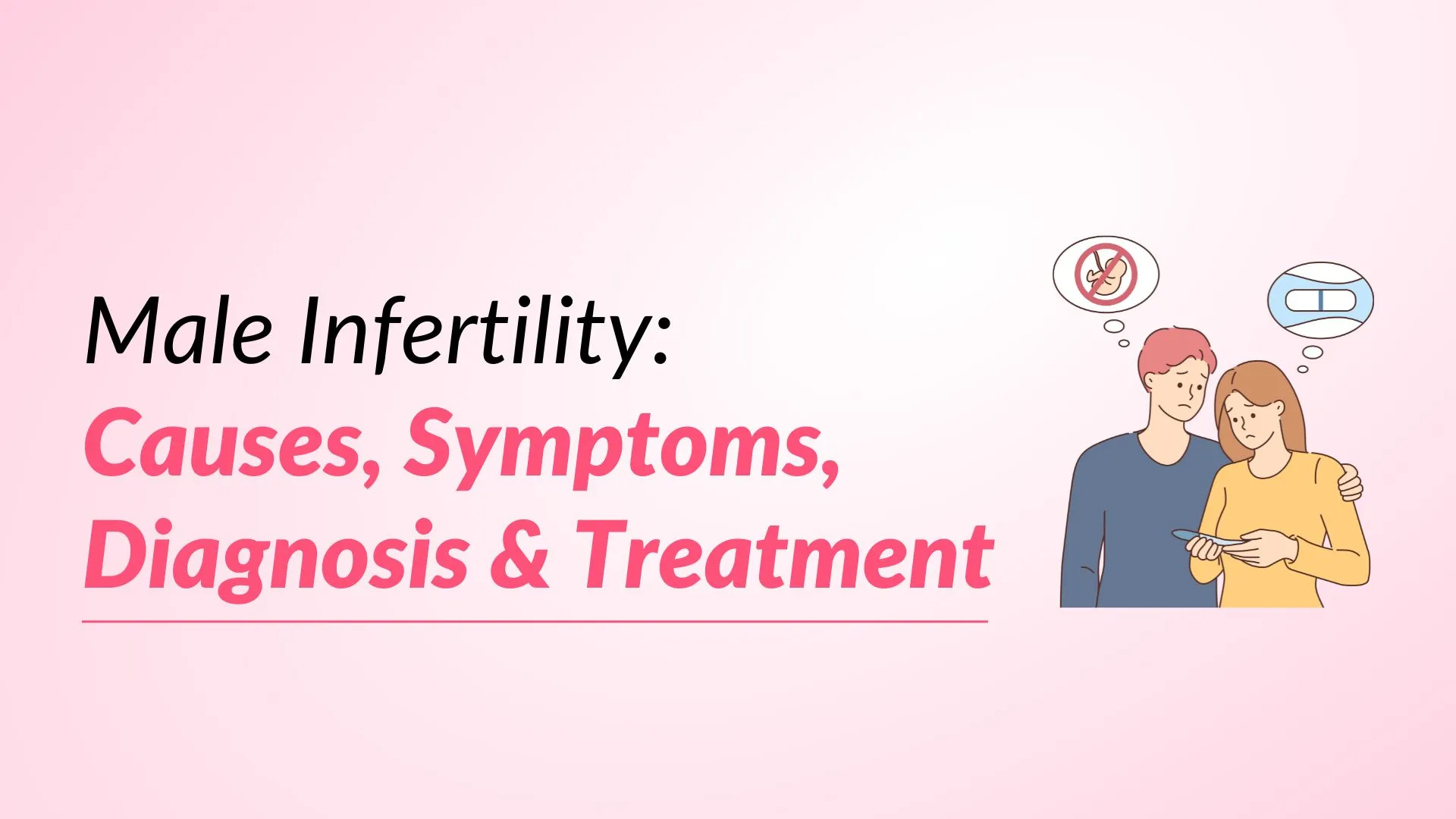Reviewed By: Dr. Jyothi C Budi – Medical Director at Ferty9 Fertility Clinic, Secunderabad, Hyderabad
Understanding Male infertility
Male infertility is a major cause of infertility, affecting about 9–15% of the general population and comprising up to 30% of the cases. According to the World Health Organization (WHO), 72.4 million people worldwide suffer from marital infertility. 50% of pair subfertility is caused by male causes, and 9% of couples globally experience fertility problems. Accurate diagnosis and successful treatment of male infertility depend on understanding of its various related aspects.
Types of Male infertility
There are 3 types of male infertility categorized based on the underlying mechanism and semen analysis. These types are explained below:
Pre-testicular Infertility:
It involves the condition that affects hormonal regulation sperm production from healthy testicles.
Hypogonadotropic Hypogonadism: It is a condition affecting testicular function. It can be caused by genetic abnormalities, pituitary tumours, or severe systemic illnesses. It can be congenital, occurring in 1-10:100,000 live births or acquired due to certain medications, pituitary lesions, encephalic trauma (damage in brain), and systemic diseases.
Erectile Dysfunction: Erectile dysfunction (ED) is a growing global issue affecting the males above 40 years, causing inability to achieve and maintain an erection for sexual performance. The condition is influenced by organic, psychogenic, and mixed factors, simultaneous disorders or diseases of diabetes, cardiovascular disease, and neurologic disorders.
Testicular infertility:
This condition involves issues directly affecting the testicles that leads to the inability of sperm production despite adequate hormonal stimulation.
Varicoceles: It is a medical condition that involves abnormal dilation and enlargement of the scrotum, causing swollen vessels. It might cause discomfort, testicular atrophy, and fertility issues. They are of significant concern among men, particularly in their reproductive age.
Genetic abnormalities: Infertile men often have abnormal numbers of chromosomes being a common issue. Klinefelter syndrome is the most common genetic abnormaility, affecting 14% of azoospermic men (semen of men with no sperm). This syndrome leads to small testis and failure in sperm production.
Infections: About 15% of men with infertility have bacterial pathogens in their semen, potentially threatening sperm production, function, and transport. Chronic orchitis can lead to irreversible damage to testis that affect the sperm production and ejaculate quality due to exposure to pathogenic bacteria.
Undescended Testicles: Testicles should be in the scrotum. When they do not descend from the abdomen, it can negatively impact the sperm production, resulting in reduced sperm count and motility due to high temperature exposure.
Exposure to Toxins: Certain environmental toxins, radiation and certain medications can directly impact the testicular tissue and sperm production.
Post-testicular Infertility:
In this category, the production of sperm in the testicles will be normal, but the presence of a block or issue that prevents their ejaculation into the semen.
Obstructive Azoospermia (No sperm in semen): Blocks present in the epididymis, vas deferens, or ejaculatory ducts might prevent sperm from being released. These blocks can be caused due to certain infections and surgery (like vasectomy), absence of the vas deferens by birth or other conditions.
Retrograde Ejaculation: Sperm is expelled backward into the bladder instead of coming out through the penis during ejaculation.
Causes of Male Infertility
The problems of male infertility may be due to some specific reasons that are categorized into 3 based on their ability to function, deliver to the uterus and other combined factors. These are discussed below:
Sperm Function Issues:
Low Sperm Count (Oligospermia): The possibility of fertilization reduces when there are fewer sperms available.
Poor Sperm Motility (Asthenozoospermia): The inability of sperm to move efficiently to reach and fertilise the egg is known as poor sperm motility.
Abnormal Sperm Morphology (Teratozoospermia): A significant proportion of sperm with irregular morphologies can make it more difficult for them to fertilise an egg. This condition is known as atypical sperm morphology.
Sperm Delivery Issues:
Blocks in the Reproductive Tract: Sperm discharge in the ejaculate may be hindered by obstructions in the ejaculatory ducts, vas deferens, or epididymis. These obstructions may result from congenital disorders, infections, or surgical procedures.
Retrograde Ejaculation: During ejaculation, sperm enter the bladder rather than leaving the penis. This can be caused by nerve damage, medications, or surgery.
Erectile Dysfunction (ED): Inability to get or keep an erection can hinder sperm delivery and successful sexual activity.
Hypospadias: a disorder in which the urethra opens on the underside of the penis.
Other Factors:
Age: Sperm quality and quantity might progressively decrease with age, even though males can continue to be fertile for longer than women.
Obesity: Hormone levels and sperm parameters might be impacted by being overweight or obese.
Heat Exposure: Regular exposure to high temperatures, such as in hot baths, saunas, or tight clothes, can momentarily reduce the sperm count.
Symptoms of Male Infertility
Male infertility does not show any visible symptoms in general cases. Most of the men who struggle with fertility issues have normal appearance and sexual function. However, below given are the possible signs or conditions that might suggest an issue:
Problems with Ejaculation: Having trouble during ejaculation or simply ejaculating a tiny amount of fluid might be a concern.
Erectile Dysfunction (ED): The inability of male to attain or maintain an erection.
Pain, Swelling, or a Lump in the Testicular Area: This can be a sign of an infection, varicocele, or any other underlying problem.
Recurrent Respiratory Infections: Any respiratory issues can also result from certain genetic disorders that are associated with infertility.
Loss of Body Hair or Hormonal Imbalances: This might indicate an issue with testosterone production in the male.
Small, firm testicles: This might be a sign of a problem with the growth or operation of the testicles.
Sperm count test: A low sperm count discovered through testing is generally the first obvious sign of male infertility.
It is important to keep in mind that male infertility cannot be ruled out if these symptoms are not visible. The accurate method for determining male fertility is a semen analysis.
The Diagnostic Process
Male infertility diagnosis requires complete analysis, which usually consists of:
Physical examination and medical history: Your doctor will inquire about your lifestyle, medications and any previous infertility problems. The prostate, penis, and testicles will be examined by a doctor during physical examination.
Semen Analysis: Semen analysis is the basis for male infertility diagnosis. One or more semen samples must be taken in order to evaluate sperm count, motility, morphology, volume, and other aspects. Following the instructions of the lab is crucial for accurate findings.
Hormone Testing: Follicle-stimulating hormone (FSH), luteinizing hormone (LH), prolactin, and testosterone levels can be measured using blood tests. These hormones are essential for the production of sperm.
Genetic Testing: Genetic testing (such as a karyotype or Y-chromosome microdeletion analysis) may be advised if the semen analysis shows certain significant abnormalities or if there is any family history of genetic disorders.
Post-Ejaculatory Urine analysis: This test finds sperm if present in the urine after ejaculation to determine if there is any chance of retrograde ejaculation.
Testicular Biopsy: To directly measure sperm production, a little tissue sample may occasionally be extracted from the testicle of the male and when examination of semen reveals no sperm (azoospermia), it will be typically done.
Vasography: To detect if any blockages, a dye is injected into the vas deferens during an X-ray treatment. This test is conducted when there is a doubt of blockage.
Treatment Options for Male Infertility
Treatment is based on the underlying cause of male infertility and the specific circumstances of connection of the couple with one another. Advanced assisted reproductive technologies (ART) and lifestyle modifications are alternatives.
Medicines for Hormonal Imbalances: Certain medicines and hormone injections are two examples of medicines that can help boost sperm production if hormonal deficits are found.
Antibiotics for Infections: Antibiotics are used to treat infections of the reproductive system. This can stop additional harm even if it might not always restore fertility.
Drugs for Erectile Dysfunction: A number of drugs are available to help enhance erectile function and make sexual activity easier.
Surgical Interventions
Varicocelectomy: For certain men, surgically repairing a varicocele might increase sperm count and quality.
Surgical Correction of Blockages: In order to enable sperm discharge in the ejaculate, blockages in the vas deferens or epididymis may occasionally be surgically fixed. The tubes can be reconnected using techniques like vasoepididymostomy or vasovasostomy.
Microscopic Epididymal Sperm Aspiration (MESA) and Testicular Sperm Extraction (TESE): These are surgical techniques used to remove sperm directly from the testicles or epididymis in men who have serious problems or obstructions with sperm production. Intracytoplasmic sperm injection (ICSI) is the next step in IVF using the recovered sperm.
Assisted Reproductive Technologies (ART)
Intrauterine Insemination (IUI): Around ovulation, concentrated and concentrated sperm are inserted directly into the woman’s uterus. For minor sperm abnormalities or problems with sperm motility, this may be beneficial.
In Vitro Fertilization (IVF) with Intracytoplasmic Sperm Injection (ICSI): ICSI is a specialised procedure in which an egg is directly injected with a single sperm. When sperm are surgically extracted or there is severe male factor infertility, such as low sperm count, poor motility, or abnormal morphology, this works very effectively.
Donor Sperm: Using donor sperm for IUI or IVF is an option to get pregnant if a man is unable to generate viable sperm.
Summary
Male infertility affects nearly half of infertile couples and can result from hormonal issues, testicular problems, or blockages in sperm delivery. Key causes include low sperm count, poor motility, genetic conditions, infections, and lifestyle factors like obesity and heat exposure. Diagnosis involves semen analysis, hormone tests, and sometimes surgery. Treatments range from medications and surgery to assisted reproductive technologies like IUI and IVF with ICSI, depending on the cause.



